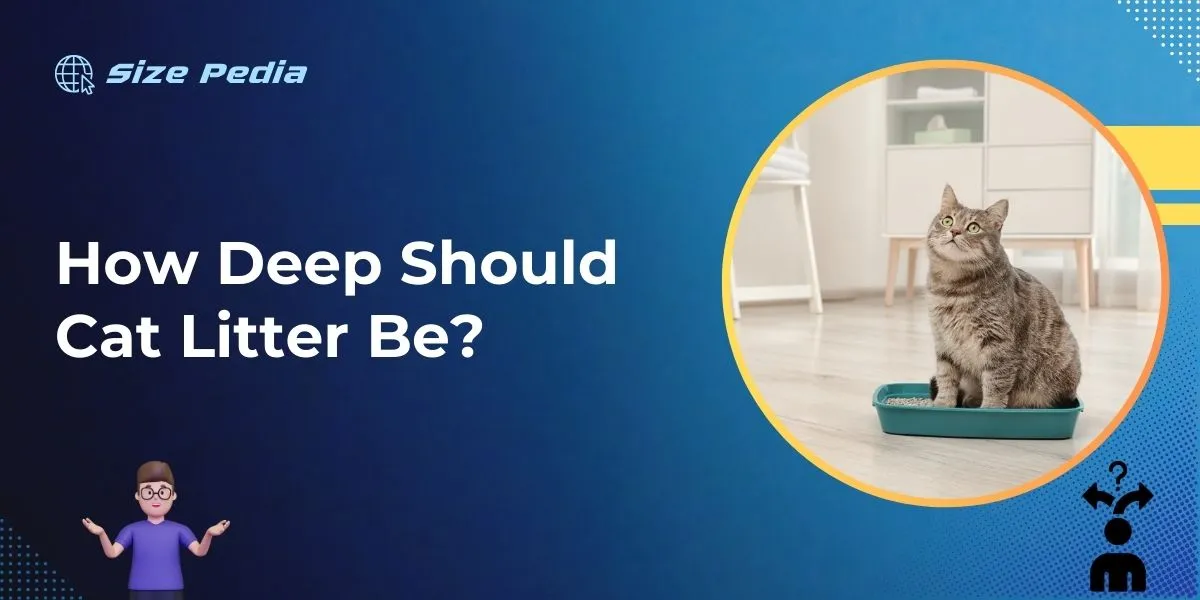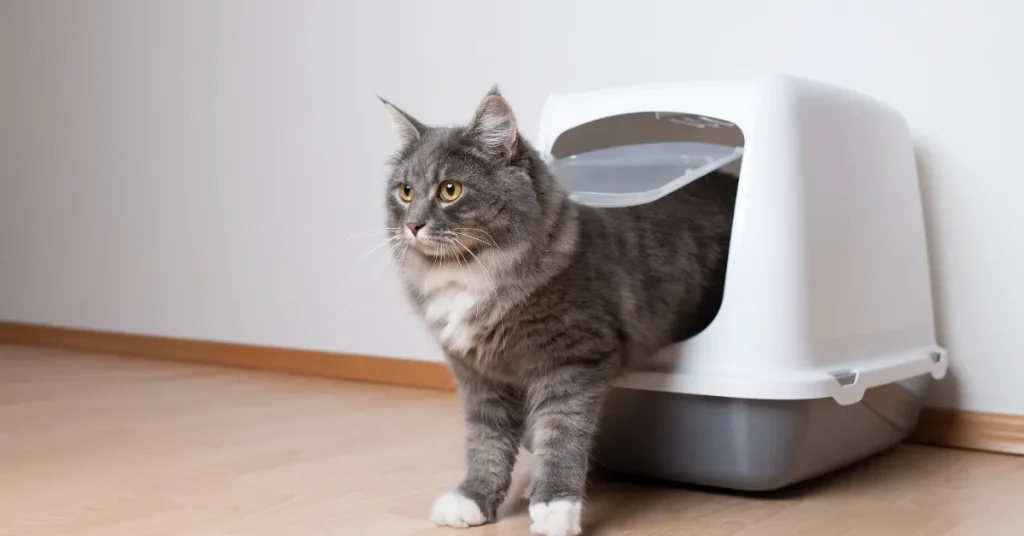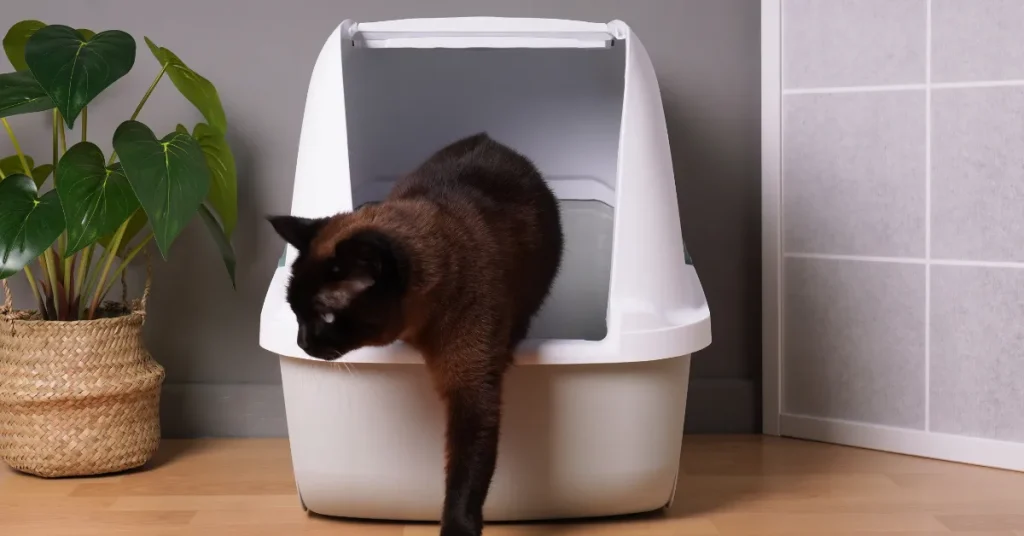Cat litter should be 2-3 inches deep in the litter box. This depth helps minimize waste and odor.
Selecting the right depth for cat litter is vital for the comfort and cleanliness of your feline friend’s bathroom area. A layer of 2-3 inches is perfect for allowing cats to instinctively dig and cover their waste without excessive spilling or tracking litter outside the box.
It is a delicate balance that ensures the litter remains effective in odor control and easy for pet owners to clean.
Proper litter depth can also reduce the frequency of litter replacement, making it a cost-effective and efficient way to maintain your cat’s hygiene. Keep this simple guideline in mind to keep your cat happy and your home clean.

The Science Of Litter Depth
Curious about how deep your cat’s litter should be? The answer lies in understanding both cat behaviors and the physical properties of litter materials. Let’s delve into the science to ensure your feline friend is happy and your litter box is effective.
Cat Behaviors And Preferences
Cats have specific litter needs, often driven by instinct and comfort. Scratching and burying are natural behaviors, so litter depth is key to accommodate these actions.
- Some cats prefer shallow litter for easy access and clean paws.
- Others need enough litter to dig and cover up after using the box.
- Observation of your cat’s habits helps determine the ideal depth.
Physical Properties Of Litter Materials
To optimize litter depth, consider the type of litter you’re using. Different materials can influence how much litter you should pour into the box.
| Litter Type | Optimal Depth | Reason |
| Clumping Litter | 3-4 inches | Allows for solid clumps and easy scooping. |
| Non-Clumping Litter | 2-3 inches | Prevents excessive waste and keeps litter fresh. |
| Crystal Litter | 1.5-2 inches | Maximizes absorption and minimizes tracking. |
The right depth ensures effectiveness and ease of maintenance, while also catering to your cat’s natural instincts.
Determining The Perfect Litter Depth
Determining the Perfect Litter Depth is crucial for your cat’s comfort and health. It also influences how clean your home stays. Cats have unique preferences, as do their human companions.
Finding the ideal balance requires considering a few key factors. Let’s dig into the details to ensure your furry friend is happy when they visit their box.
Using Cat Size As A Guide
The size of your cat plays a major role in deciding litter depth. Bigger cats need more litter to cover their waste, while kittens require less. A general rule is:
- Kittens: 1-1.5 inches
- Small Cats: 1.5-2 inches
- Large Cats: 2-3 inches
Observe your cat’s behavior. If they hesitate or look uncomfortable, the depth may need adjustment. Always maintain enough litter for them to dig and bury efficiently.
Adjustments For Multiple Cats
Homes with multiple cats might need a unique approach. More cats mean more use and faster litter degradation. Start with:
- 2-3 inches of litter
Monitor the litter box daily. Notice when it appears messy or overused? Add more litter. A clean and adequate amount of litter can reduce conflicts between cats. Here’s a simple table guide for multiple cats:
| Number of Cats | Recommended Depth |
| 2 Cats | 3-4 inches |
| 3 or more Cats | 4-5 inches |
Still finding litter outside the box? Consider larger boxes or even adding another. A good rule is one litter box per cat, plus one extra.
Pros And Cons Of Varying Depths

Knowing the right depth for cat litter can be a game-changer for your furry friend’s bathroom habits.
The depth of the litter not only affects your cat’s comfort but also how easy it is for you to clean. Let’s dive into the pros and cons of varying depths to help you decide the best for your cat.
Shallow Litter Insights
A shallow bed of litter might seem like a good idea to save on litter and ease the cleaning process. Here are the benefits and downsides to consider:
- Less Litter Use: Cats don’t bury their waste deep, saving you litter.
- Lighter Boxes: They are easier to move and clean.
- Prevents Digging: For cats that love to dig, shallow litter can discourage mess.
| Consequence | Shallow Depth |
| Tracking | More litter gets tracked outside the box. |
| Odor Control | Less litter means smells might not get trapped well. |
| Comfort | Some cats dislike too little litter and may avoid using the box. |
Deep Litter Considerations
On the flip side, a deep layer of litter can feel like a luxury for some cats. Let’s weigh the benefits against the potential drawbacks:
- Better Odor Control: More litter means better absorption of smells.
- Happy Diggers: Cats that love to dig have plenty of space to do so.
- Mess Management: A deeper bed can contain the litter more effectively.
Yet, the deeper the litter, the heavier the responsibilities:
- Heavy to Handle: Deep litter makes the litter box weighty and hard to move.
- Cost Increase: You use more litter, which ups your expenses.
- Cleaning Challenges: Waste could be harder to scoop from the depths.
Remember to balance the depth based on your cat’s preferences and your cleaning routine. Don’t be afraid to adjust as needed.
Health Implications Of Litter Depth
Understanding how deep cat litter should be is crucial. Cats are clean creatures by nature. The right litter depth ensures their comfort and hygiene.
An incorrect depth can lead to health and behavioral issues. Exploring the right balance is therefore key to a happy, healthy cat.
Impact On Cat Hygiene
Let’s delve into why litter depth affects cat hygiene:
- Too shallow, and waste may not be fully covered, causing odor and bacteria to spread.
- Too deep, and cats may dislike the feeling, leading to unclean habits.
A depth of 2-3 inches is optimal for most cats to bury waste properly without making a mess.
Preventing Litter Box Aversion
Getting litter depth right keeps cats happy and using their boxes:
- Avoid too little litter; can cause discomfort and exposure to urine and feces.
- Avoid too much litter; can be overwhelming and discourage use.
- Maintain a consistent depth for a routine cats trust.
Maintaining consistency in litter depth helps prevent aversion and keeps your cat’s bathroom habits regular.
Practical Tips For Maintaining Optimal Depth

Keeping your cat’s litter box depth right is key for their happiness and hygiene. Cats are tidy creatures by nature. A litter box that’s too shallow or too deep can stress your feline friend. Follow these practical tips to ensure your cat’s comfort and the box’s cleanliness.
Regular Litter Box Maintenance
Regular cleaning keeps litter at the perfect depth. Here’s how to do it:
- Check daily: Scoop waste every day to keep litter fresh.
- Top up: Add new litter to maintain depth after scooping.
- Full change: Replace all litter and clean the box every two weeks.
Choosing The Right Litter Box
Consider these factors to choose a box that helps control litter depth:
| Feature | Importance |
| Size | A large box prevents litter from spilling. |
| Depth | High sides help maintain litter depth. |
| Design | Choose one that suits your cat’s comfort and habits. |
Addressing Common Litter Box Issues
When cats make a mess, it’s time to re-think the litter box. Depth of litter plays a role in common issues. Perfecting depth can solve many problems.
Managing Odor And Tracking
Cats dig in their litter box before and after use. The right amount of litter can decrease smells and stop litter from spreading.
- Three inches deep is best for locking in odors.
- Odor control litter can help too.
- Mats and textured pads capture stray litter from paws.
Dealing With Litter Scattering And Mess
Scattered litter isn’t just messy; it’s annoying. Keeping it contained is key. Let’s look at ways to reduce the mess:
| Tip | Benefit |
| High-sided box | Prevents litter kick-out |
| Litter with larger granules | Less likely to scatter |
| Covered litter box | Contains litter and spray |
FAQs About How Deep Should Cat Litter Be
What Is The Ideal Depth For Cat Litter?
Cat litter should typically be about 2-3 inches deep. This depth allows cats to comfortably dig and bury their waste while minimizing litter use and keeping the box clean.
Can Too Much Litter Harm My Cat?
Excessive litter depth, over 3-4 inches, can cause litter wastage and potentially deter your cat from using the box if they dislike deep litter. It’s best to stick with a moderate amount.
How Often Should I Change Cat Litter?
Litter should be scooped daily, with a full change and box cleaning every 1-2 weeks. This maintains a hygienic environment for your cat and prevents unpleasant odors.
Does Litter Depth Affect Odor Control?
Yes, proper litter depth helps to absorb and contain odors. Around 2-3 inches is optimal for controlling odors without excessive litter use, which ensures the litter performs effectively.
Conclusion
Determining the optimal depth of cat litter isn’t just about preference. It’s about providing a clean, inviting space for your feline friend.
Aim for a depth that ensures easy use and effective odor control, typically 2-3 inches. Remember, the right balance will keep your cat happy and your home fresh.
Resources:
1. https://www.cdc.gov/parasites/toxoplasmosis/gen_info/faqs.html
